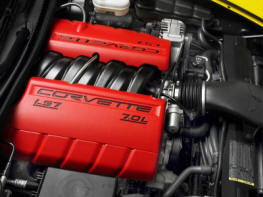|
FOR RELEASE:
2005-02-08
New Corvette Engine
Shatters Previous OHV RPM Limits
PONTIAC, Mich. - GM
engineers have achieved a feat many speculated was not possible. The
new LS7 7.0-liter OHV (overhead valve) V-8 engine for the 2006 ZO6
Corvette will not only achieve 500 horsepower but will be capable of
running up to 7100 rpm. The previous limit was 6600 rpm in the
6.0-liter LS2.
 With
this new engine GM is showing multi-valve overhead cam performance
is achievable with a two-valve cam-in-block engine. For the new ZO6,
higher rpm allows the driver to remain in first gear to just over 60
mph, contributes to higher top speed and improves overall vehicle
performance. The LS7 is one of the first automotive OHV production
engines in the industry capable of over 7000 rpm. With
this new engine GM is showing multi-valve overhead cam performance
is achievable with a two-valve cam-in-block engine. For the new ZO6,
higher rpm allows the driver to remain in first gear to just over 60
mph, contributes to higher top speed and improves overall vehicle
performance. The LS7 is one of the first automotive OHV production
engines in the industry capable of over 7000 rpm.
The new ZO6's sub
four-second 0-60 mph time is achieved in part by the extended rpm
range and the ability to remain in first gear past 60 mph. The
over-190 top speed of the ZO6 is partially due to the speed
capability of the engine. As aerodynamic drag becomes a factor at
higher speeds, the capability to run higher rpm allows the
transmission to be run in a lower gear generating more effective
torque at the rear wheels. Also, having the ability to shift all
gears at higher speeds improves elapsed times whether on a road
course or drag strip.
"For a production
engine to run at this high of an rpm blurs the lines even more
between OHV and OHC (overhead cam) design," said Dave Muscaro,
assistant chief engineer for small block engines. "We took a
complete systems approach to achieve the high rpm. We have a tight
valvetrain design along with some race-inspired materials for the
reciprocating components like titanium intake valves and connecting
rods."
OHV engines use
pushrods to activate the valves via rocker arms, whereas with OHC
engines the valves are typically actuated directly via finger
followers. The extra mechanical movement and weight of the
components of an OHV valvetrain present challenges to higher rpm.
The LS7 design and use of lightweight, stiff components, along with
GM's economy of scale, make higher rpm obtainable in a production
OHV engine.
"The new LS7 cylinder
head gave us the opportunity to design a new high-revving valvetrain,"
said Jim Hicks, LS7 valvetrain design engineer. "The new valvetrain
had to be as stiff and light as possible to assist meeting the
engine's aggressive performance targets without compromising idle
quality and low emissions. Stiffness is increased with larger
diameter pushrods and rocker arms optimized through extensive finite
element analysis."
The LS7's 1.8:1
rocker arm ratio and titanium intake valves contribute to a lower
effective mass (compared to the LS2 base Corvette engine) in spite
of larger and stiffer valvetrain hardware. Idle quality and
emissions performance is achieved with the help of a more aggressive
cam that provides more lift and duration while still keeping overlap
area to a minimum.
"We consulted with
our Motorsports group on numerous design aspects of the cylinder
head design, said Hicks. "We adopted some of the latest ideas that
have been successful in the Nextel Cup and the American Le Mans
Series including valve centerline positions, valve angles, valve
sizes and rocker arm ratio."
Due to the relatively
large bore and stroke (104.8 x 101.6mm) of the LS7, light weight
pistons, piston pins, titanium rods and a steel crankshaft are also
used to achieve extended rpm. The flat top pistons with race-ready
valve reliefs are 482 grams each and use a shortened lightweight
piston pin. Each forged titanium rod weighs only 464 grams which is
almost 30 percent less than each rod in the LS2. The forged steel
crankshaft is stronger, stiffer and designed to handle high-speed
loads.
|
